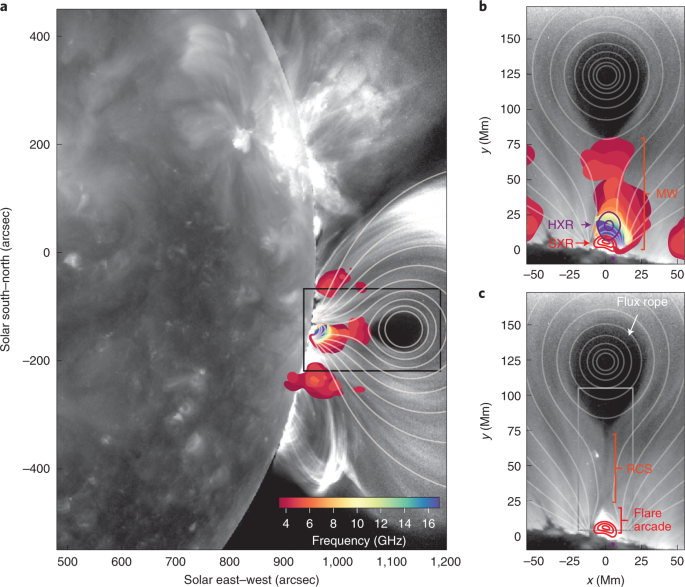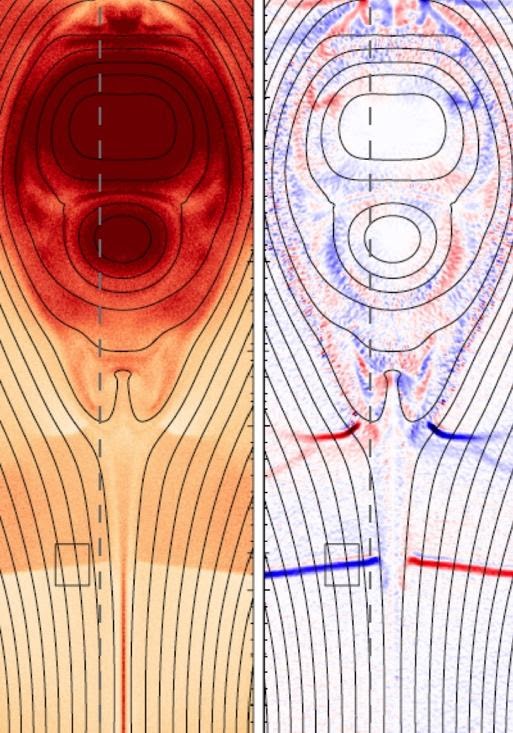 This image, taken from a recent paper written by SolFER members, shows observations and modelling of an eruptive solar flare from September 10, 2017. The grant of computer time will allow SolFER members to understand better the energetic particles produced by this and other similar eruptions. Members of the SolFER collaboration have been awarded a substantial grant of computer time on the world-class Frontera supercomputer through the Large-Scale Community Partnerships program run by the University of Texas at Austin.
This image, taken from a recent paper written by SolFER members, shows observations and modelling of an eruptive solar flare from September 10, 2017. The grant of computer time will allow SolFER members to understand better the energetic particles produced by this and other similar eruptions. Members of the SolFER collaboration have been awarded a substantial grant of computer time on the world-class Frontera supercomputer through the Large-Scale Community Partnerships program run by the University of Texas at Austin.
 Two images from a simulation, similar to those to be performed on Frontera, that examined the production of energetic particles during solar flares. The left panel shows the plasma density and the right the component of the electric field parallel to the local magnetic field. Magnetic field lines are overplotted in black in both panels.SolFER (Solar Flare Energy Release) is a multi-institution collaboration funded by NASA’s DRIVE program to study the explosive release of magnetic energy in solar flares and the associated production of energetic particles. It brings together 12 institutions and more than 50 researchers with expertise in observations, theory, numerical modeling, and computer science. Figure 1 shows an example of the solar flares that SolFER will explore. Figure 2 shows an example of the type of simulation that will be performed on Frontera to model these flares and the associated production of energetic particles.
Two images from a simulation, similar to those to be performed on Frontera, that examined the production of energetic particles during solar flares. The left panel shows the plasma density and the right the component of the electric field parallel to the local magnetic field. Magnetic field lines are overplotted in black in both panels.SolFER (Solar Flare Energy Release) is a multi-institution collaboration funded by NASA’s DRIVE program to study the explosive release of magnetic energy in solar flares and the associated production of energetic particles. It brings together 12 institutions and more than 50 researchers with expertise in observations, theory, numerical modeling, and computer science. Figure 1 shows an example of the solar flares that SolFER will explore. Figure 2 shows an example of the type of simulation that will be performed on Frontera to model these flares and the associated production of energetic particles.
The Frontera supercomputer at the Texas Advanced Computing Center (TACC) currently ranks ninth on the twice-annual Top500 list, which ranks the world’s most powerful non-distributed computer systems. Located at The University of Texas at Austin, the National Science Foundation (NSF)-supported Frontera is the fastest university supercomputer in the world. To match what Frontera can compute in just one second, a person would have to perform one calculation every second for about a billion years.
The proposal team includes members from two universities, a Department of Energy national laboratory, and a NASA science laboratory. The Principal Investigator, Bill Daughton, works at the Los Alamos National Laboratory. Other members of the team include Spiro Antiochos (Goddard Space Flight Center), Harry Arnold (University of Maryland), Joel Dahlin (Goddard), Rick DeVore (Goddard), Jim Drake (Maryland), Marc Swisdak (Maryland), Fan Guo (Los Alamos), Xiaocan Li (Dartmouth College), and Qile Zhang (Los Alamos).
